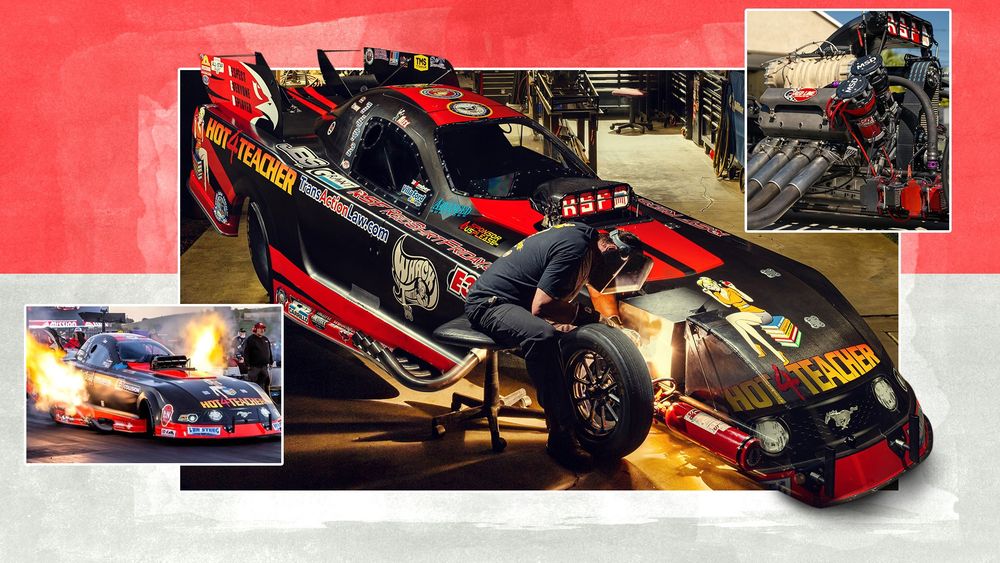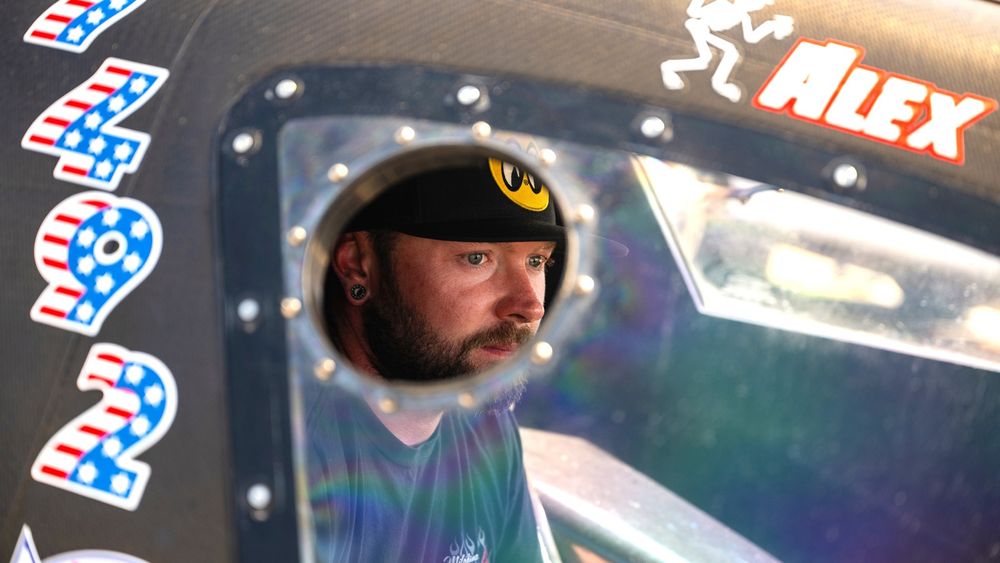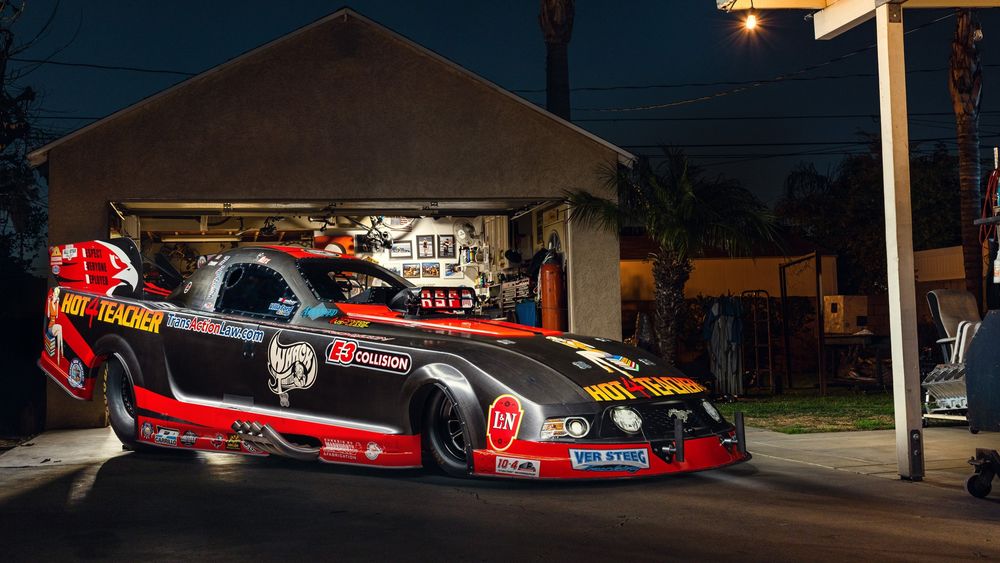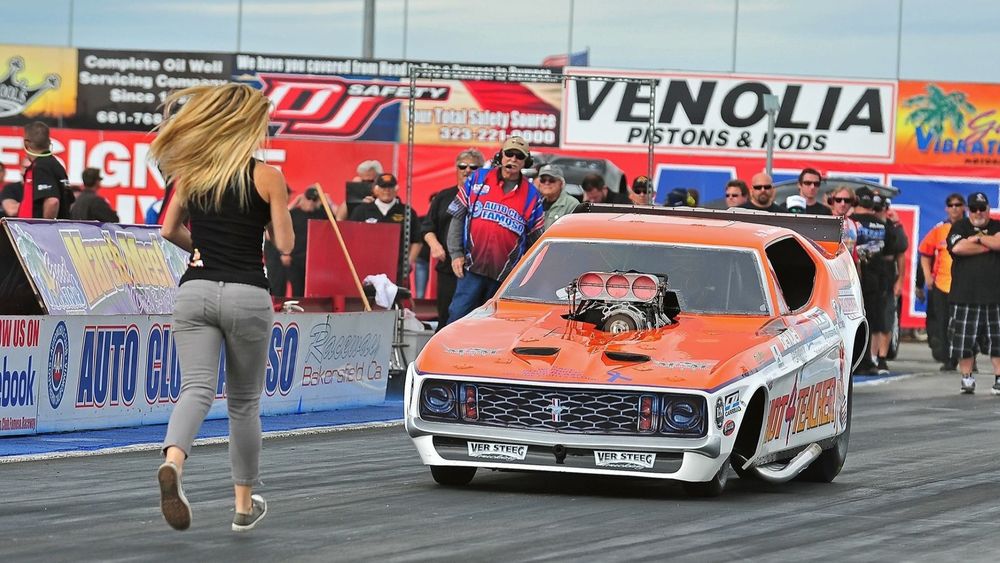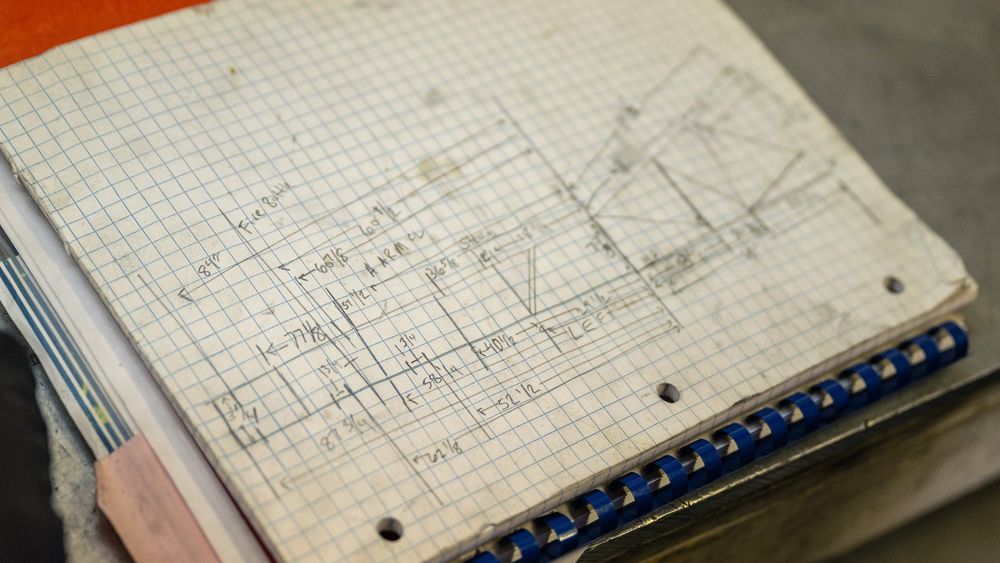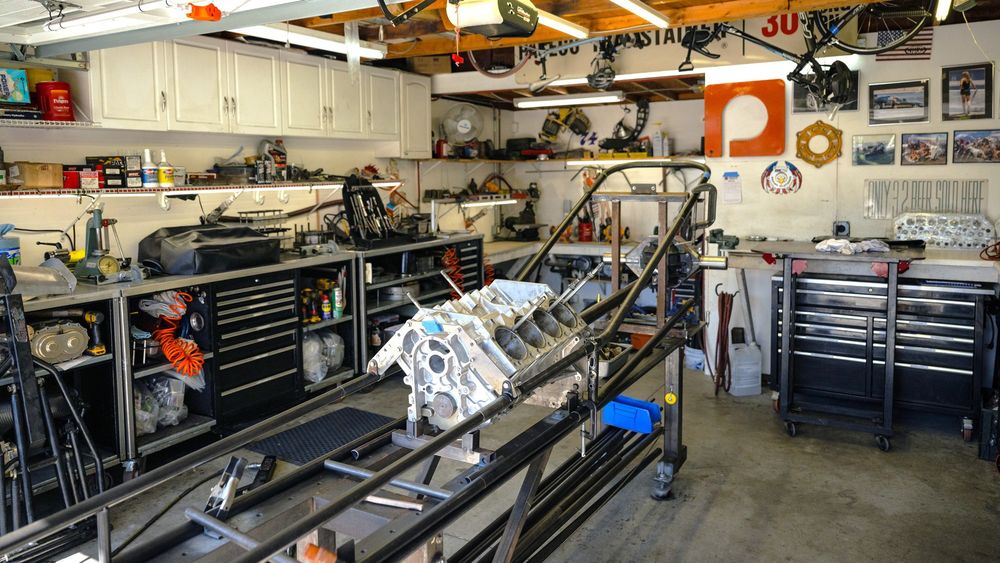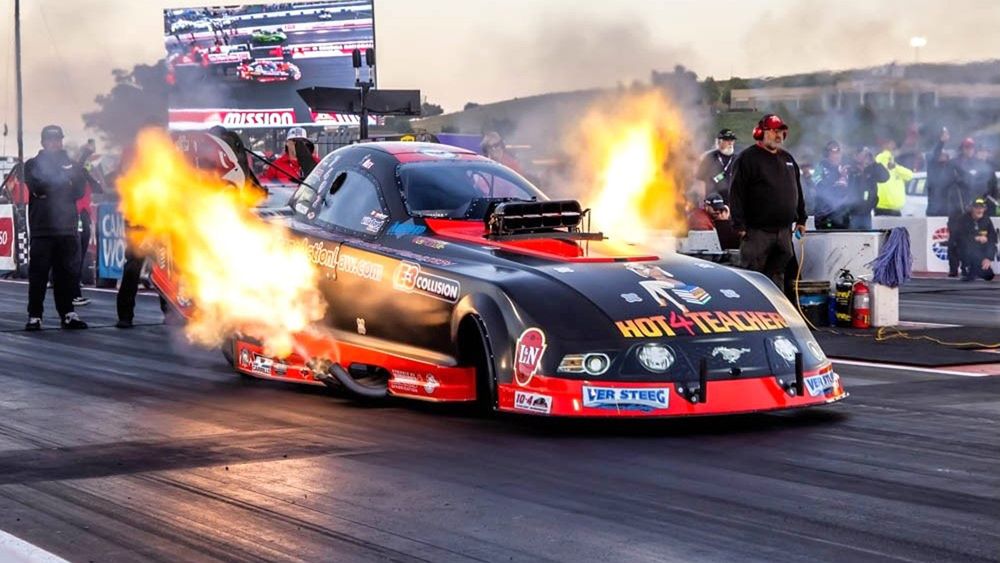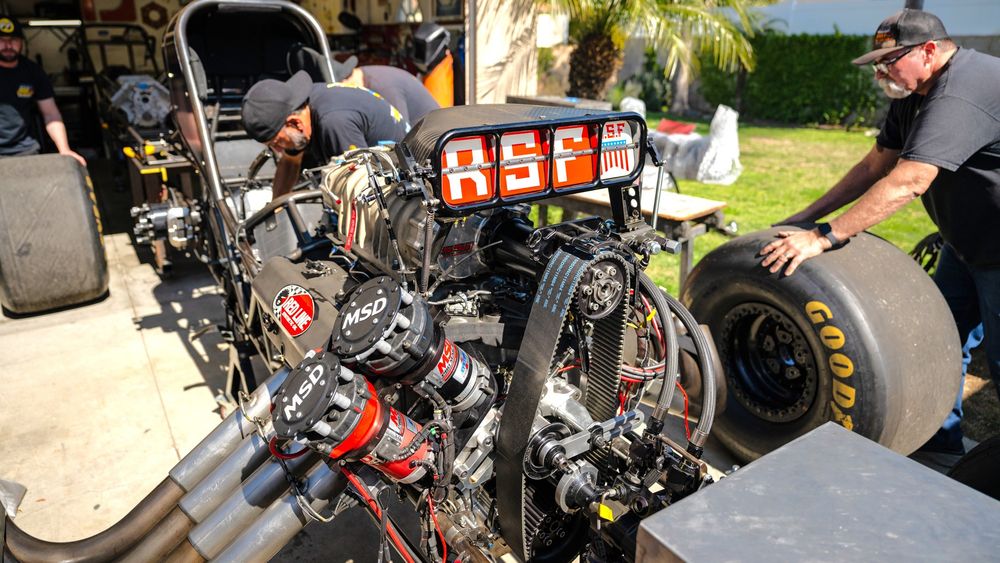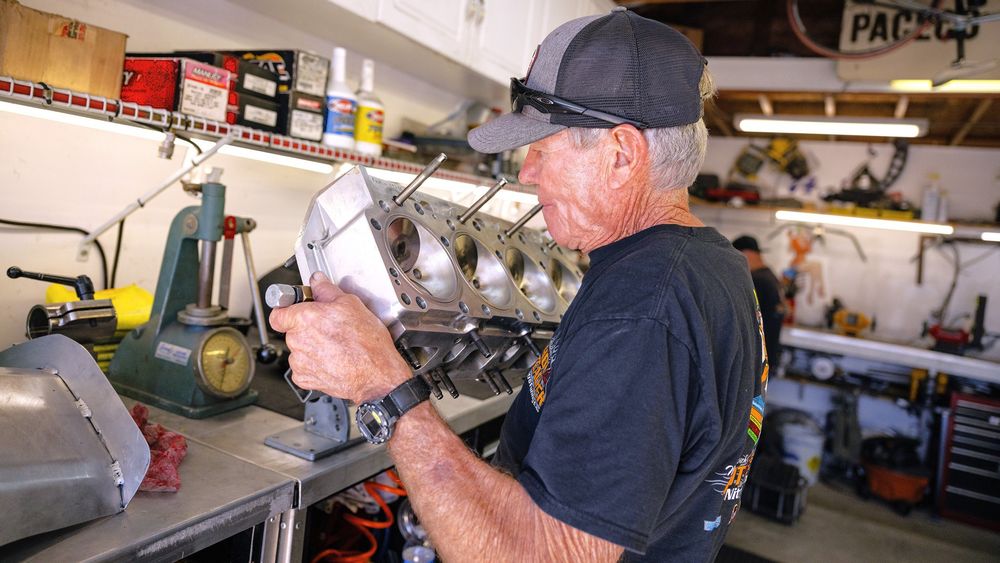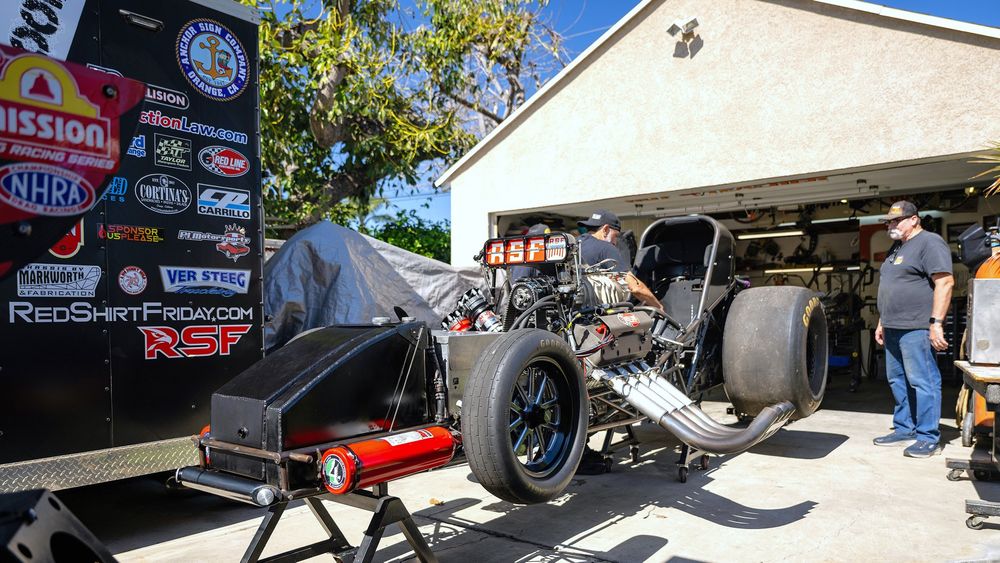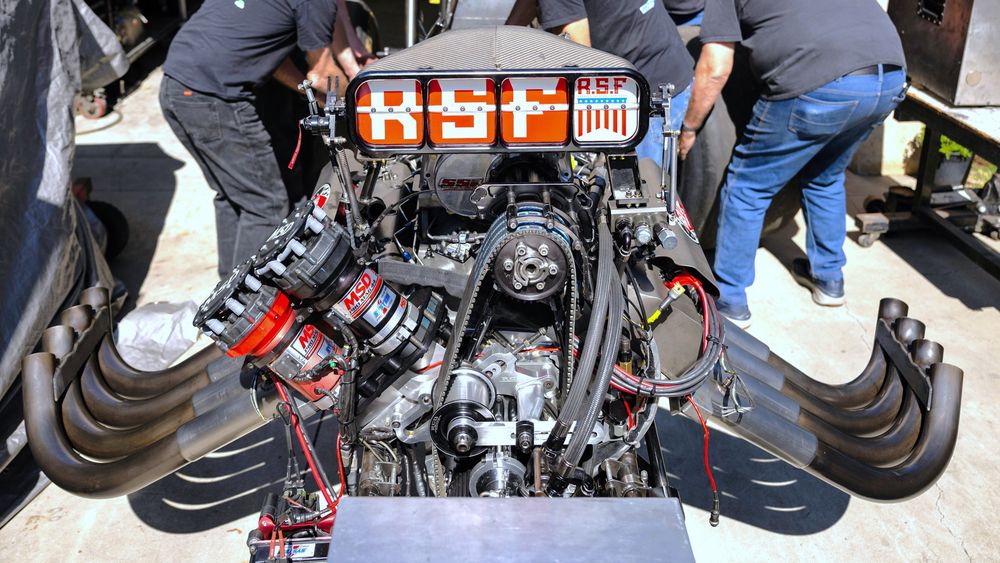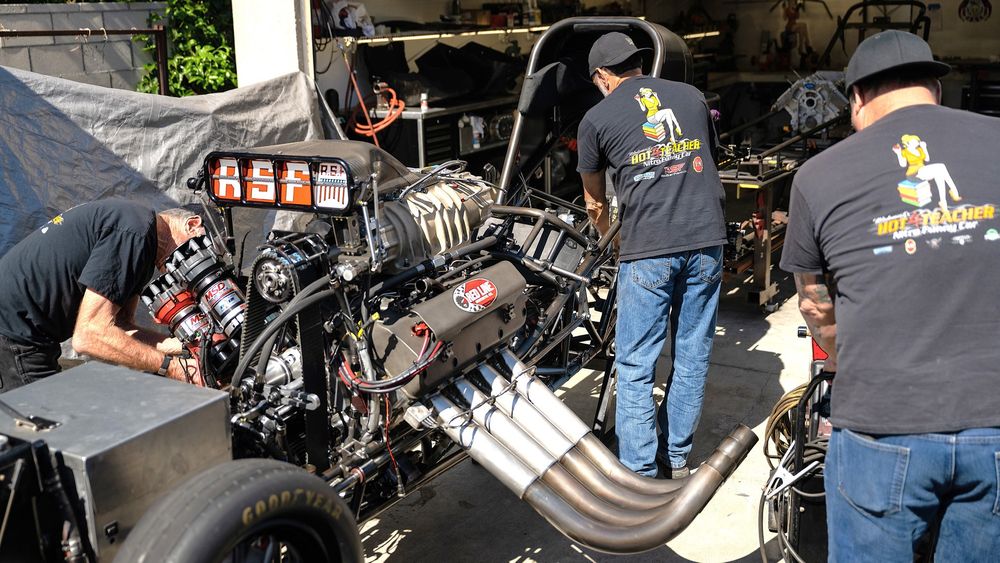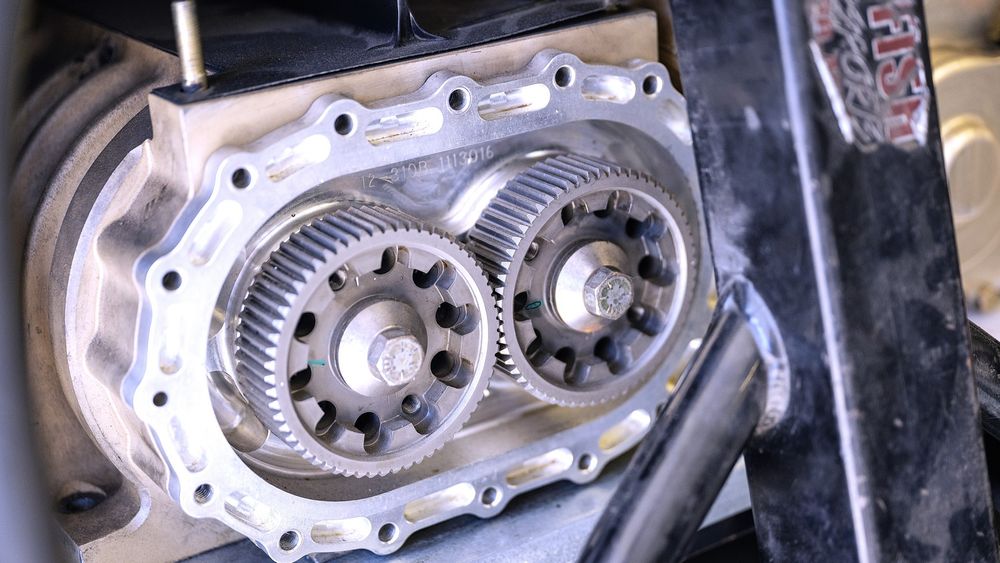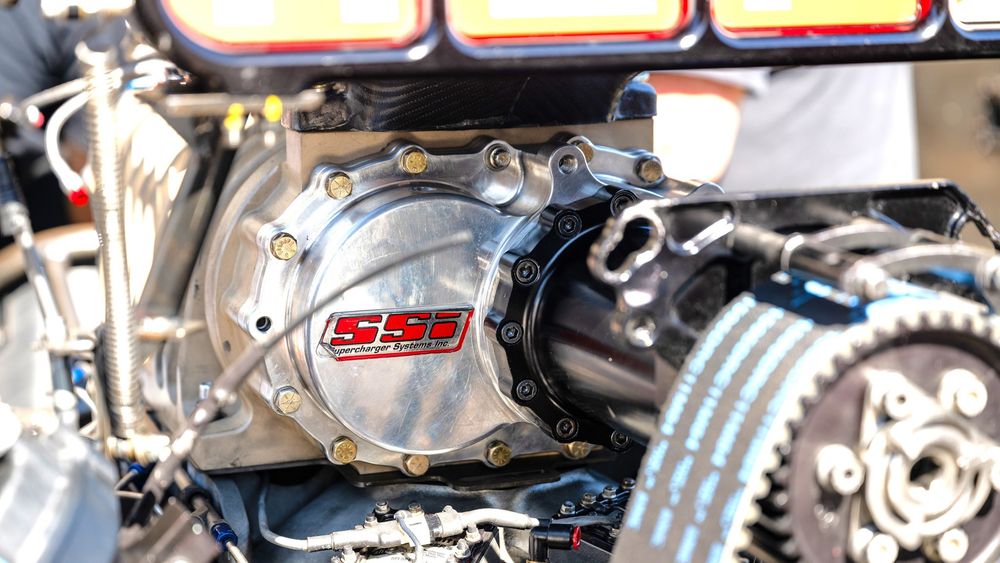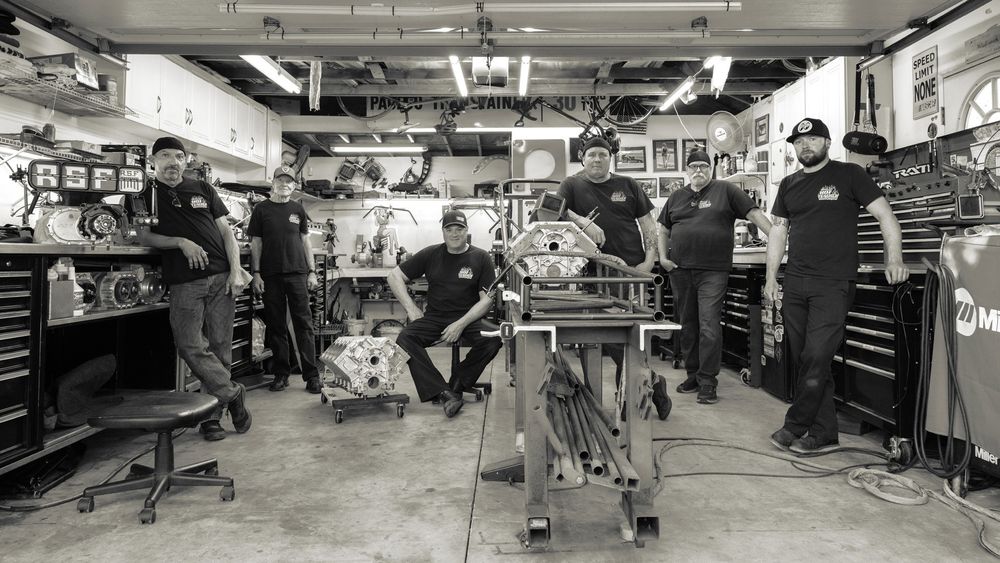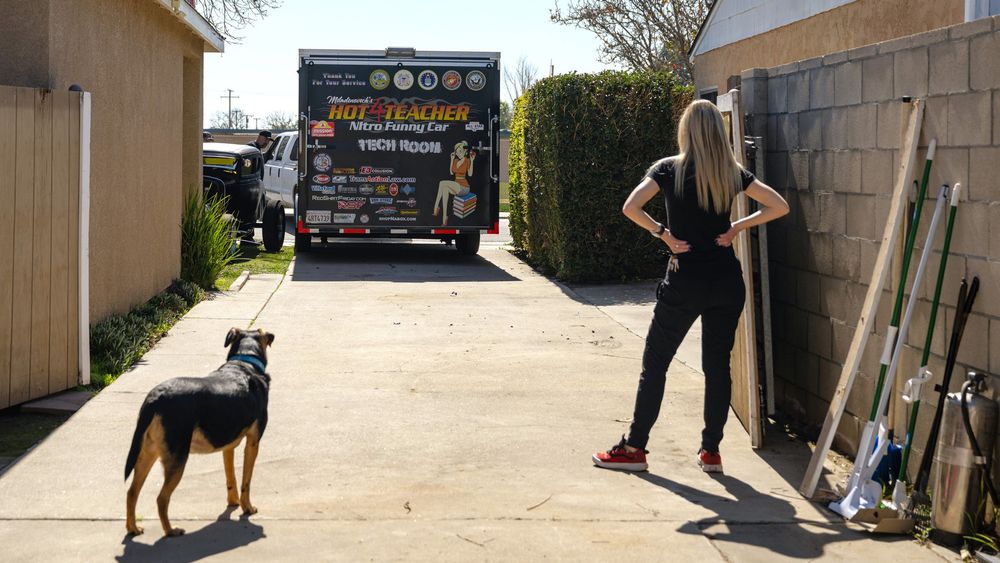Garage-Built NHRA Top Fuel Funny Car Defies All Odds
Nobody told Alex Miladinovich a regular Joe can’t build and run an 11,000-horsepower monster in the NHRA’s premier class, so he did.
Statistically, it borders on the improbable that an average drag-racing fan could race and qualify for the NHRA’s Top Fuel Funny Car ranks at a national event level with a car he built in his garage, yet here we are talking with Alex Miladinovich, a 48-year-old longshoreman mechanic who works at the Port of Los Angeles and lives in Orange County. During the week, Alex is responsible for helping move thousands of tons of freight through the port safely and efficiently, but his dream has always been to drive a race car. While Alex has yet to become a household name in NHRA Top Fuel Funny Car fandom, he has amassed a following among Top Fuel insiders, including hardcore fans, drivers, and crew chiefs. You might not know who Alex is, but his famous opponents sure do. He’s a scrappy, artful competitor who stretches every nickel into a dollar, and he hasn’t forgotten his humble roots.
AI Quick Summary
Alex Miladinovich defied odds by building and racing a Top Fuel Funny Car from his garage, reaching NHRA's top ranks. A self-taught mechanic and racer, he constructed his car with limited resources, gaining respect among fans and competitors for his dedication and skill.
This summary was generated by AI using content from this MotorTrend article
Read Next
0:00 / 0:00
“This car we started running in 2019,” Alex says of the unsponsored “Hot 4 Teacher” Top Fuel Funny Car. “I raced Nostalgia Funny Car for about 10 years before that.” And in case you’re wondering, Alex has had no special training, no Daddy Warbucks sponsor, and no secret source of funding. He’s a true privateer of the sort that, once upon a time, was commonplace in the nascent world of drag racing but has since been replaced by corporate sponsorship. The typical professional motorsports career arc usually means climbing the ladder through the sportsman ranks over many decades with relatively few ascending into the pro classes.
So how did a blue-collar aspirant like Alex make the grade? His story sounds like that of a lot of us, at first. “I had a ’67 Camaro that I didn’t street race,” Alex says. “I just took it to the local racetrack, L.A. County Raceway, and at the time there was Terminal Island Brotherhood Raceway. When I first started, I was just a punk kid that wanted to race and meet girls at the racetrack, but then I realized I should’ve gone and learned engineering. I went to Cal-State Long Beach and got a marketing degree. I kinda wished I learned more about engineering.”
The Long Road to NHRA Top Fuel Funny Car
The next step Alex took is fairly customary for a drag racer trying to balance the gear-jammer life with a job in the real world: He made the jump from a street car to a dedicated race car. One subtle difference was the influence of Southern California’s historical role in the sport and a well-timed opportunity to own a piece of that drag racing history. That happy accident would turn out to be a gateway drug for much bigger things. “I just ran 13s, and then I came across, in the city of Orange, a guy that had an old Woody Gilmore car that they turned into a Super Comp car,” Alex says. “I took all my money that I could and borrowed and stole to get it. They had a California Classic series, they called it, and it was kind of like the early version of Goodguys—some modern-day heritage series.”
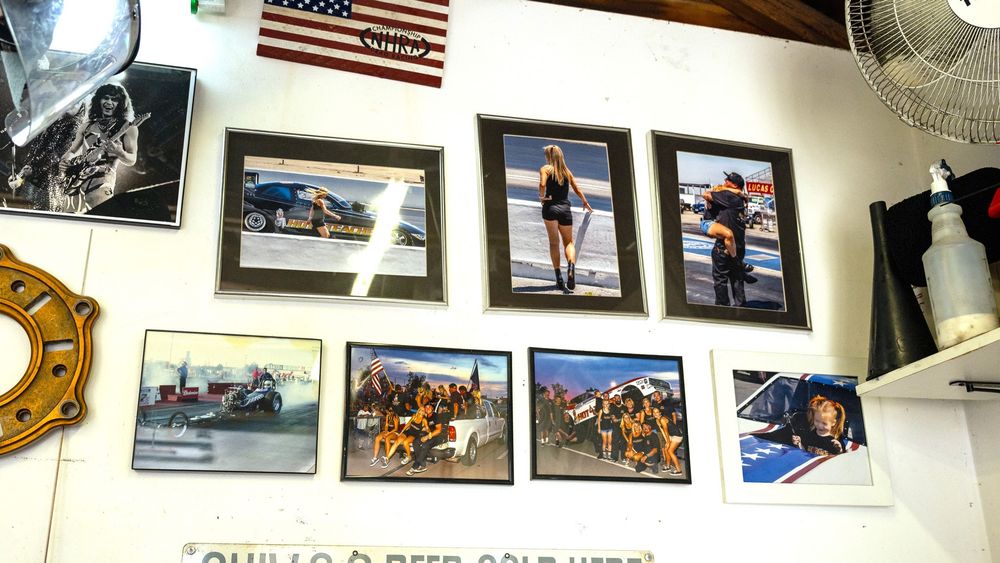
Miladinovich garage wall is a Rosetta stone for his career. Eddie Van Halen shot is veiled reference to “Hot For Teacher,” featuring Alex Van Halen’s nitro Funny Car-inspired drum solo intro. Woody Gilmore dragster and Miladinovich’s teacher wife, Marcie, also feature prominently.
The Gilmore car—a vintage-era slingshot fueler repurposed as a bracket machine—had a blown alcohol-fed small-block, and here is where Alex’s path begins to part ways from the typical Pro Sportsman route taken by most serious weekend racers. By 2000, about five years after he bought it, the Woody Gilmore car had been replaced by a clone, also with an alcohol-fed blown small-block, this one built by Alex himself—his first home-built chassis. Then a huge step toward the nitro Funny Car came in 2008 when Alex took the dive into Nostalgia Funny Car with a 4,000-hp Keith Black 426ci Hemi on nitro and another chassis of his own making. This class shares many of the mechanical attributes with NHRA Top Fuel Funny Car racing, with some important differences.
Related: Fast and Dangerous: What It's Like to Drive a Nostalgia Nitro Funny Car
“To put it into perspective, I raced Nostalgia Funny Car for 10 years,” Alex says. “That was, in my opinion, the perfect training ground for anyone who wants to make the move to Top Fuel Funny Car. Minus the shifting, that’s the only difference from the perspective. From the launch, yes, it’s a lot more powerful. The mega-monster motor, but you have to drive a Nostalgia Funny Car because they don’t have the downforce, and they don’t have the power. They don’t have suspension like a Pro Mod car, but the Nostalgia Funny Cars, you have to work them because they’re a short-wheelbase Funny Car with 4,000 horsepower.”
Building an NHRA Top Fuel Funny Car Chassis from Scratch—In Your Garage!
The final step into a genuine NHRA Top Fuel Funny Car in 2018 was a big one, but California’s crucible of nostalgia drag racing had put Alex in contact with many of the greats. It was a big step, and Alex had been paying rapt attention. There would be no buying his way into the ranks; he was determined to build from scratch. “This is brand new,” Alex told HOT ROD. “It’s a chassis that I built with a couple of my crew members. Rob Markworth (a.k.a. ‘Big Dummy’) and Gary Potekian helped build it. The three of us built that car. It’s a copy of a Steve Plueger chassis. He’s built all the Funny Cars for Force, Jim Dunn, Gary Densham, Cruz Pedregon, Lombardo, Pisano, back in the day. So if you lived in L.A. and ran Funny Cars, you would run one of Steve’s chassis. Force won, I want to say, 12 championships with his cars. But what had happened is when he added Tony Pedregon to the team, Steve could only make 12 cars a year because it was just him and his partner, his welder, and he didn’t have any interest in growing. He was getting older, and he actually wanted to retire. So Steve could only build so many cars a year, and that’s why Force made the change to McKinney.”
All this is a long way of saying the universe of Funny Car builders is incredibly small, and building your own with direct input from the experts has its advantages. When your life is on the line and you’re building your own 300-mph, 11,000-hp car, you take good notes. Alex’s account of building a Plueger-clone chassis is fascinating: “I became friends with Steve through a mutual friend, and I worked on the car that Dale Pulde drove in 2003, and that’s kind of where I learned Funny Car fabrication. So when they had the Force and the Bernstein crashes that one year, around 2007 or 2008, someone convinced NHRA to change chromoly tubing from Condition-N to heat-treated, so they completely redesigned the chassis. I never understood that, because since the conception of drag racing and aerospace, everything was built out of 4130 Condition-N, but they thought if you went to the heat-treated tube, it would be safer. That actually proved to be wrong. The cars would crack, and they had to go back to the Condition-N and make it mandatory. They increased the tubing size and wall thickness, so if you imagine the bottom framerail of 1-3/8-inch down to 1-1/4-inch out the front, well they made the back framerails top and bottom, they had to be inch and a half, 0.095 [wall thickness]. NHRA took the specs and made it pretty darned close to what these cars were, and there’s two or three different variations, and we go with the style that Steve has.”
Riding the Rocket the First Time
There comes a point in every Top Fuel driver’s life when the car is built, the prep is done, and you face your first real run down the track. The NHRA’s check-out procedure for new drivers is strict and formulaic for a reason, but there’s no real way to ever prepare yourself for the violence and unbridled force of 11,000 hp. It helps, however, to have veteran drivers around to guide you. In Alex’s case, it was Ron Capps and Pulde who provided the sage advice. Alex: “Ron Capps told me, ‘I’m going to give you the best analogy. Now here’s the difference: You’re gonna drive to 200 feet, and at 200 feet, whichever way the car is going, you’re just a passenger,’ because the downforce on these wings is pretty much driving the car. Dale [Pulde] had made the comment one time when his car was acting up: He turned the wheel, and the wheels would turn, and the car continued to go straight. You’re pretty much a passenger. What they told me, about half track, when the clutch goes to lock up, it’s like the race restarted all over again. You pull 4.5 g’s at the stuff of the throttle, and at the clutch lock, it’ll go straight to 6.5 g’s. That’s when the ride gets pretty wild.”
The inputs a driver can make to a nitro-burning Funny Car on a pass are relatively limited, and much of the effort goes not so much to driving the car but toward surviving the ride and maintaining your faculties. “Actually, you have to use the pilot technique when they take off from aircraft carriers,” Alex says. “You have to hold your breath with each stage and flex your muscles, because if you do not do that, you’ll actually start to see stars around your vision down the track. You do have to ‘lock up.’ The best way to contain it is like trying to contain a three-year-old running around on ice skates. You’re fighting the car, the g forces, and as soon as you see the finish line approaching, you dump the ’chutes, especially at Pomona because of the short run-off. By the time you cross the finish line, you want your ’chutes out 100 percent.”
It's been said that driving down track in a Top Fuel car is a lot like an astronaut riding a Saturn V rocket into orbit. The combination of high sound pressure level, vibration, and g force would be sensory overload for most people, and in the case of a Top Fuel Funny Car, drivers pilot their machine at least as much by feel as anything else. “Violent and loud aren’t even the right words for it,” Alex says. “You hear it in the stands—that’s what the driver feels inside the car, the pressure. With a Funny Car, you’re sitting right over the rearend, and you feel every input the car’s gonna do. When it’s going to smoke the tires, you feel the actual tires’ growth and the g forces run out on the car. It feels like your head’s going to hit the dash, but when that clutch locks up and it starts to make its move, that’s when it gets really, really fun.”
Preparing mentally and physically for the impending violence of a full Top Fuel pass is crucial, and some first-time drivers aren’t always ready for it. The confines of the driver pod with rollcage bars in close proximity, helmet, padding, restraints, and HANS device certainly help, but there is a technique to strapping in that’s unique to Top Fuel racing. Alex explains: “You have to adjust your helmet restraint and pull your helmet down so your head is essentially hunched over, but make sure you can see your field of vision because your helmet restraint will stretch. I’d been told you want the belts so tight you can’t breathe, because of the stretch. When I hit the wall at Pomona in 2021, I was like a BB in a boxcar bouncing around. That just reaffirmed that intense feeling of force and power and why it needs to be tight. Dennis Taylor, who makes all our safety belts, said the reason why the belts have to stretch is because if they didn’t, your body would be the one that would be stretching, which in turn would be broken bones. The head restraint stretching is part of it, and that’s just when you really know you’re on a good pass.”
The 11,000-Horsepower Hemi
Powering this monster is a badass 500-cubic-inch, 11,000-hp nitromethane-fed V-8 Hemi that Alex and his brother, Robert, assemble in-house. “We run this car out of a two-car garage,” Alex says. “I don’t have a business. I don’t have a warehouse that I park stuff at. We do it in my garage. Now to say that isn’t entirely true because I use my brother’s garage. We do all the short-blocks at his house and the cylinder head work at my brother’s. My brother is funny. He’s a true talent and mechanic. He’s a thinker. He’s the one who makes sure everything in the motor is right. He measures everything. He takes them apart when they come back from the races and just goes over them with a microscope. That tells the story. He likes to joke, ‘These motors were fine when I gave them to you.’ So that’s the ongoing thing between him and I. He goes, ‘Sometimes I wish I had a sister.’ And I say, ‘Would you have as much fun?’”
Having some of the best Top Fuel talent in the business located in Southern California has its advantages, and knowing the right people on a first-name basis produces results. “We run Alan Johnson engine blocks and the John Force Racing cylinder head,” Alex says. “We’re actually able to get John Force Racing superchargers, and those things are just magic. I don’t know what they do different, but Austin Coil, Bernie Fedderly, Jimmy Prock, John Medlen, all those guys did something to that design of blower.
Related: John Force Reflects on Funny Cars Over the Past 40 Years
“When they machine the cases, they somehow have an oval or football shape, so at the stuff of the throttle, the rotor warps and will actually continue to seal with the case. I just find that amazing, because when we re-strip our blowers, we put ’em together with two-thousandths thickness with the Teflon on the case clearance. You gotta put lots of lube on ’em, and if you rebuild the supercharger in the summertime and it gets put in the car in the wintertime, it’s going to be very tight. We run a Sonny Bryant crank, and whatever he does to those metals, and the abuse that we do to these is insane.”
Blower Magic
It’s been the case for some time that Top Fuel Hemi V-8s make so much power that modern dynos are incapable of absorbing the punishment, meaning no one knows their actual power output. The track is the dyno, but there are ways to get to a good estimate, and the technique was pioneered by Kenny Bernstein’s guru, Dale Armstrong, some years ago, by measuring the blower’s output using a V-8 to power it. Referring to that breakthrough, Alex explains: “He had a shop in Orange, and I was fortunate to be around these old drag racers when I was a kid. Dale Armstrong took a big-block Chevy and connected it to a supercharger and tried to dyno it. When they engaged the clutch to connect the motor to the blower, the supercharger stalled the engine. Can you imagine a big 454 Chevrolet—the way they come from the factory they make 400 horsepower—you dump the clutch, and it snuffed out and stalled a big-block Chevy. That’s impressive. They said it takes about 1,000 horsepower to turn over the supercharger. Now that also just blows my mind. One entire cylinder is dedicated to being able to just turn the blower over. Even if you just turn the motor over with a ratchet and the spark plugs are out of it, you’ll get a pop of air. It’s pretty impressive. Actually, it’s ridiculous.”
The Psychic Payoff
On its surface, you might think racing NHRA Top Fuel is all about winning. That’s certainly part of it, but just getting to that point has its own rich rewards. Winning, nevertheless, is the performative goal of the sport, and being the underdog in a sport with greats like John Force can seem insurmountable. “To be honest, we’re racing against teams with $3 million budgets,” Alex says. “I can’t outspend that. What I can do is make myself available to the fans, to the average spectator. I get a lot of people from the stands that come up and thank me for inspiring them, and I’m like, ‘What are you talking about? I’m just a welder, man.’ They go, ‘No, you’re the guys who made it. You’re going up against the big dogs,’ and I appreciate that. I just want to pass that along to someone else.”
Alex Miladinovich 2019 NHRA Top Fuel Funny Car Specs
- Engine: 500-cubic-inch Chrysler-based Hemi V-8, aluminum alloy Alan Johnson engine block, approximately 11,000 hp, CP Carillo pistons, Miller connecting rods (7.106-inch length), Bryant crankshaft (4.50-inch stroke), Jesel rocker arms (1.6 ratio), Bullet 4-7 swap camshaft, John Force Racing cylinder heads and supercharger, Hussey copper head gaskets, Manley valves, Mahle bearings and rings, Gates blower belts (11mm pulley), Redline oil, dry sump (System 1 oil pump), JT Stewart barrel valve, Performance Data Systems data logger
- Compression height: cylinder 1 and 2, 1.57-inch; cylinder 3 and 4, 1.58-inch; cylinder 5, 1.61-inch; cylinder 7, 1.59-inch; cylinder 6 and 8, 1.60-inch (“This balances out the burn and gets the EGTs within 100 degrees”)
- Ignition: MSD 44-amp mags (x2), MSD solid core wires, Champion spark plugs
- Transmission: Reverser Moore performance
- Clutch: 10.5-inch DSR five-disc, 18-lever
- Chassis: 125-inch wheelbase, NHRA 10.1e nitro funny car, serial number OCD129 (“Since Steve Plueger was a mentor of mine, I started numbering my chassis where he left off. He passed in 2017. I wanted to keep his legacy going.”)
- Body: 2015 Ford Mustang, carbon-fiber JFR design
- Rear tires: 36x17-inch Goodyear slicks
- Safety: Taylor Motorsport parachutes, belts, engine diaper, trans blanket
- Best e.t. (1,000 ft): 4.18/299 mph
Johnny Hunkins, born 1963, grew up mainly in Greensboro, NC. Attended Southeast Guilford High School (Greensboro) and graduated in 1981. Received a BFA degree in Art with a concentration in Design from the University of North Carolina at Greensboro (UNC-G) in 1985. The son of a music teacher and a music composer, began playing guitar at age 6, meanwhile harbored companion interests in muscle cars, model car building, NASCAR racing, and drag racing. During and after attending UNC-G, worked as an auto service writer at Montgomery Ward Auto Express. Bought a Ford Mustang LX 5.0L in 1987 which he began modifying immediately, then started contributing freelance stories to Muscle Mustangs & Fast Fords (MM&FF) in 1991. Moved to New Jersey from North Carolina and became fulltime MM&FF tech editor in the fall of 1992. Helped create, then became editor of GM High-Tech Performance (originally High-Tech Performance) magazine in 1995. While at MM&FF, invented the popular “True Street” drag racing class used by many sanctioning organizations. Moved to California in 2003 to become editor of Popular Hot Rodding magazine. In July of 2014, became editor of Mopar Muscle magazine for the rebranded TEN network. Previous and current magazine projects cars: 1987 Ford Mustang LX 5.0 (Project Excalibur), 1989 Ford Mustang LX 5.0, 1987 Buick Regal Turbo-T (2 of them), 1993 Pontiac Firebird Formula (Project Thunderchicken), 1989 Pontiac Firebird Formula 350 (Project Magnum TPI), 1994 Chevy Camaro Z 28 (The Grape Of Wrath), 1976 Chevy Camaro (Project g/28), 1968 Chevy Chevelle (Street Sweeper), 1975 Chevy Laguna S-3 NASCAR clone, 1968 Chevy Nova, and 1968 Plymouth Valiant. Other interests include fine cigars, writing and recording rock music (Hunkins is an artist on the indy label Grooveyard Records), and mid-century modern architecture and design. Hunkins lives in Desert Hot Springs, CA.
Read More
